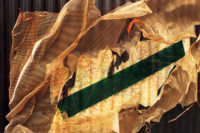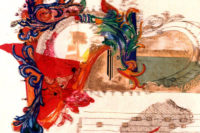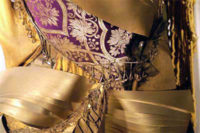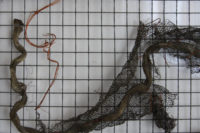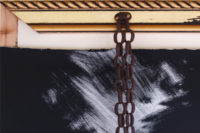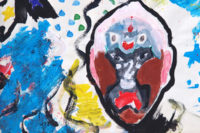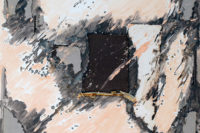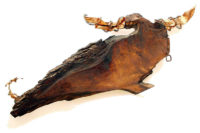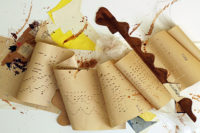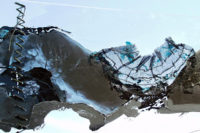Recensioni
Geografie Impossibili
La sua è pittura materica che nasce come compiacimento estetico e decorativo di immagini di più antica memoria. Un’esperienza ne alimenta la ricerca, in quel frangente ( una lunga permanenza a Bucarest, in Romania) rimane colpita dalla tradizionale pittura su vetro, icone che adottano i colori ma non ne restituiscono la luce, lasciando la lucentezza alla superficie del vetro, richiamandola poi con la stessa “doratura”, che invece serviva per illuminare la pittura di icone su supporto ligneo.
E’ questa riflessione che la ispira nel cercare un supporto alla sua pittura che le potesse permettere di vivificare i colori e la lucentezza oltre che la trasparenza: il perspex ha così sostituito il vetro. Il suo lavoro ancorato alle caratteristiche di un informale materico, ne articola la spontaneità in assemblaggi e collages che inglobano, a volte sospesi nello spazio, frammenti di carte strappate, scritte che affiorano tra i colori, parole che navigano in un orizzonte di luce e colore.
Pittura su plexiglass la sua, che cerca un itinerario, una narrazione di viaggi attraverso la memoria: questa riaffiora in frammenti di cose, figure che appaiono, silouhettes di un mondo coloratissimo.
Si intravedono trasparenze doppie, nella composizione di Libri-oggetto, sempre su plexiglass, in cui le scene si sommano a scene. L’attenzione dell’artista è anche verso l’iconografia medioevale da lei ricercata in particolare nelle pagine di “ Codice Miniato”, che diviene percorso/supporto di preziosi spazi metafisici.
In altri lavori è il materiale usato che acquista propria valenza decorativa da strappi ricercati, da fratture o assemblaggi matrici, che coniugano colore e materia , sempre in sospensione e in chiave di poetiche visioni.
Gabriella Dalesio (critica d’Arte)
English version
Impossible Geographies
Her is matter painting that was born as an aesthetic and decorative pleasure of images of more ancient memory. An experience feeds her research, at that juncture (a long stay in Bucharest, Romania) she is struck by the traditional painting on glass, icons that adopt colors but do not return the light, leaving the shine to the surface of the glass, recalling it then with the same “gilding”, which instead was used to illuminate the painting of icons on a wooden support.
It is this reflection that inspires her in seeking a support for her painting that could allow her to enliven the colors and brightness as well as transparency: perspex has thus replaced glass. Her work anchored to the characteristics of an informal material, articulates its spontaneity in assemblages and collages that incorporate, sometimes suspended in space, fragments of torn papers, writings that emerge among the colors, words that navigate in a horizon of light and color.
She paints her on plexiglass and her, looking for an itinerary, a narration of travels through memory: this resurfaces in fragments of things, figures that appear, silhouettes of a very colorful world.
Double transparencies can be glimpsed in the composition of Books-Object, again on plexiglass, in which the scenes are added to scenes. The artist’s attention is also towards the medieval iconography that she sought in particular in the pages of “Codex Illuminated”, which becomes a path/support of precious metaphysical spaces. In other works it is the material used that acquires its own decorative value from refined tears, fractures or matrix assemblages, which combine color and matter, always in suspension and in the key of poetic visions.
Gabriella Dalesio (Art critic)
“Uscita dal quadro” – EXPO personale 2007 alla Banca Sella – Via Poli (Fontana di Trevi)
Il titolo in realtà implica anche un ingresso e un attraversamento, alludendo al lavoro che l’artista svolge per orientarsi su temi di attualità. “Disconosce” il tradizionale quadro su tela: infatti qui lo spettatore è chiamato a condividere intenti e modi, perché l’artista apre lo spazio, invitandolo a danzare nella continuità fisica e mentale tra l’autore e le opere rappresentate e lo spazio in quale è coinvolto.
English version
“Exit from the picture” – 2007 personal EXPO at Banca Sella – Via Poli (Fontana di Trevi)
In reality, the title also implies an entrance and a crossing, alluding to the work that the artist carries out to orient himself on topical issues. It “ignores” the traditional painting on canvas: in fact here the viewer is called to share intentions and ways, because the artist opens the space, inviting him to dance in the physical and mental continuity between the author and the works represented and the space in which he’s involved.
Arte Dannata
Quest’artista crea trasparenze, ma non solo, gioca con i colori vivaci, raramente disarmonici, seppur forti e contrastanti. Raccoglie oggetti dimenticati, perché non amati profondamente come consumismo vuole, li riunisce, li rianima, gli concede presente e futuro sottolineandone il passato contesta l’attuale morire nel nulla. Colora con passioni gestuali , rende omaggio agli alberi, alla natura, non religiosamente, ma concettualmente, non un ritorno al mistico, ma una riflessione contro chi brucia tutto e tutti, contro chi dimentica le emozioni-sentimenti-profumi-ragioni-speranze non individualiste.
Gabriella dona, indica il percorso da fare, la poetica da intraprendere: “recuperare memoria”, eliminare gli errori, dipingere il futuro con i suoni che solo la pittura può dare. Raccoglie, unisce, rielabora e propone al nostro attuale tempo che dimentica, digerendo rapido e senza sapori favole e fiabe. Così ci concede nelle trasparenze la possibilità di osservare un dipinto, lo unisce con il recupero di noi stessi, e quindi inevitabilmente indica l’amore. Lo sguardo sul mondo di questa artista attraversa diverse tecniche che comprendono immagini sia figurative che astratte, riferibili al mondo circostante oltre che a quello interiore.
Tuttavia la sua identità si dispiega in un processo creativo teso soprattutto al raggiungimento di un contatto tra visibile ed invisibile, da cui “la trasparenza” che diventa il supporto materico delle sue opere su perspex. Alla base della sua strategia, c’è la capacità di rappresentare l’impenetrabile svelandosi attraverso la conoscenza, ed è nella gestualità nel manipolare la materia, piegandola e assoggettandola, che trasferisce forza alle sue opere. Così i colori e la luce che le attraversano, si svelano, lasciando comunque un senso di non finito, ed un invito a guardare oltre
Massimo D’Andrea
English version
Damn Art
This artist creates transparencies, but not only, plays with bright colors, rarely disharmonious, albeit strong and contrasting. He collects forgotten objects, because they are not deeply loved as consumerism wants, he reunites them, revives them, grants them the present and the future, emphasizing the past and challenges the current dying into nothing. Colors with gestural passions, pays homage to trees, to nature, not religiously, but conceptually, not a return to the mystical, but a reflection against those who burn everything and everyone, against those who forget emotions-feelings-perfumes-reasons-hopes that are not individualistic .
Gabriella gives, she indicates the path to take, the poetics to take: “Recover memory”, eliminate mistakes, paint the future with the sounds that only painting can give. She collects, unites, re-elaborates and proposes to our present time that forgets, digesting fables and fairy tales quickly and without flavors. Thus she grants us the opportunity to observe a painting in transparencies, unites it with the recovery of ourselves, and therefore inevitably indicates love. The look on the world of this artist crosses different techniques that include both figurative and abstract images, referable to the surrounding world as well as to the inner one.
However, her identity unfolds in a creative process aimed above all at reaching a contact between the visible and the invisible, hence the “transparency” that becomes the material support of her works on perspex. At the basis of her strategy, there is the ability to represent the impenetrable by revealing itself through knowledge, and it is in the gestures in manipulating the material, bending and subjecting it, that transfers strength to her works. Thus the colors and the light that pass through them are revealed, leaving however a sense of unfinished, and an invitation to look beyond.
Massimo D’Andrea
Un trasparente progetto artistico
Davanti all’opera d’un artista lo spettatore a volte rimane sorpreso, altre sconcertato, e forse allora prova l’impulso di abbandonare la visione e con essa lo sforzo di comprensione dell’opera. Ma chiunque vinca l’umana pigrizia davanti al nuovo, all’inconsueto, o al diverso, chiunque riesca a rapportarsi con l’immagine artistica derubricando le proprie sedimentazioni culturali e accogliendo invece con mente “pura” i segni, i colori, la materia con cui le opere si sostanziano, ben presto rimane catturato dal mondo spirituale dell’artista e dal suo essere altro e quindi unico.
Non sempre ciò avviene, perché lo stesso albero non sempre dà buoni frutti, né il frutto eccellente è sempre ben colto, ma quando avviene è un’alchimia riuscita che fa bene alla mente e al cuore.
E certo alla mente e al cuore parlano le opere di Gabriella Porpora, fluttuando dense e colorate come nebulose in un cielo trasparente senza inizio e senza fine, proprio come noi percepiamo l’universo e come forse ci illudiamo che siamo noi stessi: senza un inizio e, soprattutto, senza una fine.
Parlano alla mente perché vi riconosciamo segni di antiche e recenti espressioni artistiche, parlano al cuore perché coinvolgono l’osservatore che prima acquisisce il colore e la simmetria dei segni, poi “penetra” l’opera attraverso la trasparenza del perspex, quindi la vive osservandola da diverse angolazioni in una luce che il supporto trasparente rende sempre nuova.
Dunque tu, osservatore, lasciati andare, almeno inizialmente, e osserva con sguardo libero le macchie di colore che si inseguono e suggeriscono, i materiali vari che una mano femminile ha disposto, sinuosi ed enigmatici. Questo è un primo modo legittimo di compenetrare queste opere, di assorbirne l’energia delle linee essenziali, dei colori ora ardenti come la tensione verso un obiettivo irraggiungibile, ora profondi e neri come voragine che tutto aspira, oppure d’ocra e di seppia come un Oriente mitizzato.
Poi, tu che osservi, puoi mettere in campo l’intelletto, e ciò che in te è sedimentato troverà molteplici corrispondenze con le opere di Gabriella Porpora.
E allora troverai squarci d’espressioni artistiche del passato, che dalle pitture rupestri scorrono, riconoscibili eppure nuovi e personalizzati, fino all’Astrattismo, all’Informale e ad un’originale polimatericità.
E troverai la luce “impressionista” che rende mutevole la pittura sulla trasparenza, e la violenza dei Fauves nelle macchie rosse esaltate drammaticamente dal nero e dal giallo, come il giallo prevale nella rievocazione della Cina, sterminato topos culturale per più di una generazione occidentale.
E poi, quando forse meno te lo aspetti, l’artista esce dal laboratorio e si inoltra nella natura, dove incontra gli alberi e la loro storia, le ferite delle loro mille striature, le macchie ora scure ora chiare che li punzecchiano minacciose, contagiose, inquietanti.
L’albero richiama le radici, il senso dell’origine, ma anche il fuoco, la distruzione, una distruzione forse non definitiva ma purificatrice e catartica. Una speranza, un auspicio? Chissà, ma certamente anche qui si ha la sensazione che il “poiein” artistico, cioè il momento creativo dello spirito, assorba tutta l’inquietudine, tutti i contrasti, forse tutta la disperazione di una generazione che continua a dire la sua, senza più certezze ma sicuramente con molta più poesia.
Aldo D’Ambrosi
English version
A transparent artistic project
In front of the work of an artist, the viewer is sometimes surprised, sometimes disconcerted, and perhaps then he feels the urge to abandon the vision and with it the effort to understand the work. But anyone who wins human laziness in the face of the new, the unusual, or the different, anyone who manages to relate to the artistic image by de-listing their cultural sedimentations and welcoming instead with a “pure” mind the signs, the colors, the material with whose works are substantiated, he soon becomes captured by the artist’s spiritual world and by his being other and therefore unique.
This does not always happen, because the same tree does not always bear good fruit, nor is the excellent fruit always well picked, but when it happens it is a successful alchemy that is good for the mind and heart.
And certainly the works of Gabriella Porpora speak to the mind and heart, floating dense and colorful like nebulae in a transparent sky without beginning and without end, just as we perceive the universe and how perhaps we delude ourselves that we are ourselves: without a beginning. and, above all, without an end.
They speak to the mind because we recognize signs of ancient and recent artistic expressions, they speak to the heart because they involve the observer who first acquires the color and symmetry of the signs, then “penetrates” the work through the transparency of the perspex, then experiences it by observing it from different angles in a light that the transparent support always makes new.
So you, observer, let yourself go, at least initially, and observe with a free gaze the spots of color that chase each other and suggest, the various materials that a female hand has arranged, sinuous and enigmatic. This is a first legitimate way to interpenetrate these works, to absorb the energy of the essential lines, of the colors now burning like the tension towards an unattainable goal, now deep and black as a chasm that aspires to everything, or in ocher and sepia as a mythologized East.
Then, you who observe, you can field the intellect, and what is sedimented in you will find multiple correspondences with the works of Gabriella Porpora.
And then you will find glimpses of artistic expressions of the past, which flow from cave paintings, recognizable yet new and personalized, to abstract art, informal and original multi-materiality.
And you will find the “impressionist” light that makes the painting changeable on transparency, and the violence of the Fauves in the red spots dramatically enhanced by black and yellow, like yellow prevails in the re-enactment of China, an endless cultural topos for more than a Western generation.
And then, when perhaps you least expect it, the artist leaves the laboratory and enters nature, where he encounters the trees and their history, the wounds of their thousand streaks, the now dark now light spots that tease them threatening, contagious , disturbing.
The tree recalls the roots, the sense of origin, but also fire, destruction, a destruction perhaps not definitive but purifying and cathartic. A hope, a wish? Who knows, but certainly here too one has the feeling that the artistic “poiein”, that is the creative moment of the spirit, absorbs all the restlessness, all the contrasts, perhaps all the despair of a generation that continues to have its say, no longer certain but certainly with much more poetry.
Aldo D’Ambrosi
Commento su “Aspetti della Gerarchia immaginifica”
Gabriella Porpora ci narra su lamiere la metamorfosi del super-io in una società multimediale : le gerarchie che popolano il nostro fantastico in una società in cui, pur nel cambiamento, divieti e proibizioni, vincoli e strade “one way”, a senso unico, dominano il rapporto esistente tra il singolo cittadino e il suo stato d’appartenenza.
Giuliano della Pergola (Professore al Politecnico di Milano)
English version
Comment on “Aspects of the Imaginative Hierarchy”
Gabriella Porpora tells us on metal sheets the metamorphosis of the super-ego in a multimedia society: the hierarchies that populate our fantastic in a society in which, despite the change, prohibitions and prohibitions, constraints and “one way” roads, one way, dominate the relationship between the individual citizen and his state of belonging.
Giuliano della Pergola (Professor at the Milan Polytechnic)
Miti antichi e libri d’arte, manichini e maschere, tematiche moderne e viaggio musicale, materia oscura e, in contrapposizione, il preludio alle trasparenze e le trasparenze stesse: la produzione di Gabriella Porpora è difficile da definire proprio perché attraverso tecniche, materiali e percezioni diverse, ci pone di fronte la realtà così com’è: immutabile ma sempre cangiante, solida ma costruita sull’aria.
Gabriella non si è mai fermata davanti alle tradizionali colonne d’Ercole artistiche: è partita da disegno e pittura pura per arrivare ad una scultura od a una tela che riproducono il mondo attraverso oggetti, i segni del percorso che spazia dal passato al futuro, attraverso il presente: suggestioni, ricordi, presentimenti diventano percepibili attraverso velette, piume, carta da musica, così che noi possiamo apprezzare, in un’opera artistica, la leggerezza e la concretezza che accomuna noi esseri umani. E questo perché una mano d’artista ha saputo accostarli a segni, forme, colori che ce li mostrano nuovi; le “cose” non sono l’opera d’arte, sono nell’opera d’arte.
L’unitarietà del tempo, che esiste al di là del nostro soggettivo frazionarlo, è chiara anche nelle tematiche moderne, che racchiudono titoli come “Ab origen”, “Radici” (quanto di più ancestrale esista) ma si volgono al presente ed a un avvenire sempre in costruzione attraverso “Paesaggio strappato” e “Metamorfosi”.
E tutto questo ci viene offerto con una serenità evidente: non c’è l’ansia della ricerca, ma la curiosità appagata, che approda alla composizione del tutto.
Le opere di Gabriella certo non affermano con supponenza chi siamo, ma con sagace e ariosa perizia ci pongono di fronte a molte delle stratificazioni che compongono il nostro esistere; e guardarci ci piace e ci arricchisce.
Professoressa Rossella Rossi
English version
Ancient myths and art books, mannequins and masks, modern themes and musical journey, dark matter and, in contrast, the prelude to transparencies and transparencies themselves: Gabriella Porpora’s production is difficult to define precisely because through techniques, materials and different perceptions, places us in front of reality as it is: immutable but always changing, solid but built on air.
Gabriella never stopped in front of the traditional artistic columns of Hercules: she started from pure drawing and painting to arrive at a sculpture or a canvas that reproduce the world through objects, the signs of the path that sweeps from the past to the future, through the present: suggestions, memories, presentiments become perceptible through veils, feathers, music paper, so that we can appreciate, in an artistic work, the lightness and concreteness that unites us human beings. And this is because an artist’s hand has been able to approach them with signs, shapes, colors that show them new to us; the “things” are not the work of art, they are in the work of art.
The unity of time, which exists beyond our subjective fragmentation, is also clear in modern themes, which contain titles such as “Ab origen”, “Radici” (the most ancestral thing that exists) but turn to the present and to a always take place under construction through “Torn Landscape” and “Metamorphosis”.
And all this is offered to us with an evident serenity: there is not the anxiety of research, but the satisfied curiosity, which leads to the composition of the whole.
Gabriella’s works certainly do not affirm who we are with arrogance, but with shrewd and airy skill they place us in front of many of the stratification that make up our existence; and we like it and it enriches us to look at it.
Professor Rossella Rossi
Derive Linguistiche
Le meraviglie d’oriente sono tramontate nell’Ottocento con la fine delle grandi dinastie cinesi e l’apertura del Giappone agli occidentali dopo un atto di forza della flotta americana. Il resto è esotismo, curiosità e cianfrusaglie, tanto che l’Oriente si è identificato con il Giappone (il “japonisme” è stato un fenomeno anche artistico rilevante alla fine del secolo scorso) dimenticando quanto questo debba alla cultura cinese ben più antica e articolata. E la chiusura comunista che caratterizza ancora la storia attuale del “pianeta Cina” non consente ancora di entrare in contatto con una delle più antiche culture dell’uomo.
I pittogrammi cinesi che Gabriella Porpora riprende in molte delle sue opere, sono in se la forza di una tradizione che registra eventi e modificazioni traducendoli nel linguaggio dei simboli. Il pittogramma della donna registra la sua emancipazione, in senso letterale, cioè la fine della soggezione all’uomo. La conquista della posizione eretta decantata nel simbolo come figura piana, frontale, testimonia di un evoluzione millenaria. E quando l’artista riprende altri pittogrammi come il simbolo della doppia felicità o quello della scrittura tanto preziosa da essere rappresentata da un bimbo sotto tetto, il motivo non è semplicemente il ricordo di un viaggio in Cina, quanto piuttosto il tentativo di far interagire la nostra cultura con quella cinese.
Certamente il movente artistico prevale. Comunque un pittogramma dipinto e riletto dalla sensibilità dell’artista diventa opera d’arte e quindi l’origine linguistica viene in qualche modo “tradita”. Ma Gabriella Porpora non intende giocare su di un facile mistero. Il suo interesse per una cultura così distante fonda il suo operare artistico attuale. La sua ricerca di dati culturali che avvicinino Oriente e Occidente richiama alla mente le mai sopite utopie anni ’60 che cercavano la mediazione fra le distanti culture, quella occidentale inevitabilmente orientata verso l’esterno e l’esteriorità e quella orientale più spirituale che cerca sempre l’equilibrio dell’uomo nel sistema naturale. Ma in questo caso è il progetto individuale che diventa politico. L’esigenza dell’artista di approfondire una sua esperienza si riflette sulla struttura dei macro-eventi culturali. E che l’arte ricominci a porsi come centrale nella cultura dopo anni di pittura interessata solo a sé stessa, è un fatto che in questo fine secolo (e di millennio) si sta verificando sempre più spesso. Vi sono date che impongono una riflessione, che costituiscono nell’inconscio collettivo un termine cui confrontare le esperienze passate. Dopo l’edizione di Documenta IX a Kassel, ne riparleremo.
Questo spessore nell’opera di Gabriella Porpora, la sua ricerca quasi filologica d’appropriarsi anche di tecniche cinesi, non deve sorprendere in un’artista che opera da oltre 10 anni confrontandosi con un arte consapevole del ruolo che svolge nella cultura e nella società. I suoi pittogrammi anche se esteticamente pregevoli non sono rivolti semplicemente ad un’operazione decorativa. L’intervento artistico della Porpora, il suo far proprio un linguaggio lontano geograficamente ma non spiritualmente, rende chiaro il senso di un operare artistico che prova di stabilire dei punti di contatto, che cerca nell’attrito delle derive linguistiche di provocare quello stupore che ogni genuina conoscenza dovrebbe produrre. Anche nelle opere su perspex la ricerca di trasparenza assume il dato linguistico dell’attraversamento e quindi della liberazione della luce e del colore traslucido. Il concetto di “passare oltre” resta lo stesso come nell’immagine della “porta”. Il linguaggio è uno strumento per avvicinarsi alla realtà, come la densità dei cromatismi è uno strumento per avvicinarsi alla luce. Anche in questo caso, nessuna impressione superficiale è quella giusta per avvicinarsi alla pittura dell’artista.
Valerio Dehò
English version
Linguistic Drifts
The wonders of the East faded in the nineteenth century with the end of the great Chinese dynasties and the opening of Japan to the West after an act of force by the American fleet. The rest is exoticism, curiosity and odds and ends, so much so that the East has identified itself with Japan (“Japonism” was also a relevant artistic phenomenon at the end of the last century) forgetting how much this owes to the much more ancient and articulated Chinese culture . And the communist closure that still characterizes the current history of the “planet China” does not yet allow us to come into contact with one of the most ancient cultures of man.
The Chinese pictograms that Gabriella Porpora uses in many of her works are in themselves the strength of a tradition that records events and modifications by translating them into the language of symbols. The pictogram of the woman records her emancipation, in a literal sense, that is, the end of subjection to man. The conquest of the upright position praised in the symbol as a flat, frontal figure testifies to a millenary evolution. And when the artist uses other pictograms such as the symbol of double happiness or that of writing so precious as to be represented by a child under the roof, the reason is not simply the memory of a trip to China, but rather the attempt to make the our culture with that of China.
Certainly the artistic motive prevails. However, a pictogram painted and reread by the artist’s sensitivity becomes a work of art and therefore the linguistic origin is somehow “betrayed”. But Gabriella Porpora does not intend to play on an easy mystery. Her interest in such a distant culture is the foundation of her current artistic work. His search for cultural data that brings East and West closer brings to mind the never dormant 1960s utopias that sought mediation between distant cultures, the western one inevitably oriented towards the outside and the exterior and the more spiritual eastern one that always seeks the balance of man in the natural system. But in this case it is the individual project that becomes political. The artist’s need to deepen an experience of hers is reflected in the structure of cultural macro-events. And that art is once again becoming central to culture after years of painting interested only in itself, is a fact that in this end of the century (and millennium) is occurring more and more often. There are dates that require reflection, which constitute a term in the collective unconscious to compare past experiences to. After the edition of Documenta IX in Kassel, we will talk about it again.
This depth in Gabriella Porpora’s work, her almost philological search to also take possession of Chinese techniques, should not surprise an artist who has been working for over 10 years, confronting an art aware of the role it plays in culture and society. Her pictograms, although aesthetically valuable, are not simply aimed at a decorative operation. The artistic intervention of the Porpora, its making its own a language that is geographically distant but not spiritually, makes clear the meaning of an artistic work that tries to establish points of contact, which seeks in the friction of linguistic drifts to cause that amazement that every genuine knowledge should produce. In her works on perspex too, the search for transparency takes on the linguistic datum of crossing and therefore of the liberation of light and translucent color. The concept of “passing over” remains the same as in the image of the “door”. Language is a tool for getting closer to reality, just as the density of colors is a tool for getting closer to light. Again, no superficial impression is the right one to approach the artist’s painting.
Valerio Dehò
Allo Spazio Museale Sabrina Falzone dal 27 ottobre esporranno artisti di talento per la mostra d’arte contemporanea “Gli Astrattisti Contemporanei”, che sarà aperta ai visitatori fino al 5 novembre 2012 nella splendida cornice del quartiere Pagano di Milano. A pochi passi dal Duomo, la galleria espositiva celebra l’astrattismo contemporaneo come uno stile artistico rinnovato ed in continua evoluzione nel corso di un secolo di storia dell’arte: il percorso espositivo intende ripercorrere le prime tappe del movimento artistico per approdare ai nuovi orizzonti creativi di alcuni degli autori più in voga nel nostro secolo. Tra i loro nomi figurano Michele Pellicciari, singolare nella sua efficace verve pittorica dal segno immediato, Mario Formica con il suo poliedrico universo materico che sposa l’elettronica ad altri materiali, Daniela Cavallini audace nelle sue composizioni di luce e oro ed infine Valenberg con il suo astrattismo materico, scandito dall’utilizzo di tessuti, cartone e trucioli metallici. Per la scultura si confermano di innata originalità due donne: Lucia Paganini, la cui ricerca si sofferma tra la morte e la maternità, e Gabriella Porpora che suggerisce un nuovo modus di fare arte con una commistione inedita di materiali.
Artisti di straordinario talento sono stati selezionati in tutto il territorio nazionale dal critico d’arte Sabrina Falzone, curatrice dell’esposizione collettiva che si svolgerà dal 27 ottobre al 5 novembre 2012 con Inaugurazione Sabato 27 ottobre ore 18 presso lo Spazio Museale Sabrina Falzone, ubicata nel centro storico di Milano in via Giorgio Pallavicino 29 (Italia). Un appuntamento con l’arte da non perdere.
English version
From October 27th at the Spazio Museale Sabrina Falzone will exhibit talented artists for the contemporary art exhibition “The Contemporary Abstractionists”, which will be open to visitors until November 5, 2012 in the splendid setting of the Pagano district of Milan. A few steps from the Duomo, the exhibition gallery celebrates contemporary abstractionism as an artistic style that has been renewed and constantly evolving over the course of a century of art history: the exhibition itinerary aims to retrace the first stages of the artistic movement to reach new horizons. creatives of some of the most popular authors of our century. Among their names are Michele Pellicciari, singular in his effective pictorial verve with an immediate sign, Mario Formica with his multifaceted universe of materials that marries electronics with other materials, Daniela Cavallini bold in his compositions of light and gold and finally Valenberg with the his material abstraction, marked by the use of fabrics, cardboard and metal shavings. Two women confirm their innate originality for sculpture: Lucia Paganini, whose research lingers between death and motherhood, and Gabriella Porpora who suggests a new way of making art with an unprecedented mix of materials.
Extraordinarily talented artists have been selected throughout the country by the art critic Sabrina Falzone, curator of the collective exhibition that will take place from 27 October to 5 November 2012 with Inauguration Saturday 27 October at 6pm at the Sabrina Falzone Museum Space, located in the historic center of Milan in via Giorgio Pallavicino 29 (Italy). An appointment with art not to be missed.
La riflessione c’invade, non può più essere ridotta al problema della conoscenza di sé e della relazione umana: è tutto il rapporto tra uomo e società, l’immagine stessa del mondo che vengono messi in gioco.
Le immagini si fanno apocalittiche. L’esasperazione ossessiva del funzionamento burocratico della mente ( prima ancora che delle pratiche d’ufficio) è uno dei modi più frequenti con cui chi dentro di sé nega la follia urbana tenta di arginare la sofferenza di chi la riconosce. E’ un’ondata tremenda, dice Gabriella Porpora, capace di travolgere di colpo aspetti umani preziosi e genuini, ma non deve prevalere!
Dr. Novelletto
English version
Reflection invades us, it can no longer be reduced to the problem of self-knowledge and human relationship: it is the whole relationship between man and society, the very image of the world that are brought into play.
The images become apocalyptic. The obsessive exasperation of the bureaucratic functioning of the mind (even before office practices) is one of the most frequent ways in which those who deny urban madness within themselves try to stem the suffering of those who recognize it. It is a tremendous wave, says Gabriella Porpora, capable of suddenly overwhelming precious and genuine human aspects, but it must not prevail!
Dr. Novelletto
Trasparenze al nero
Artista instancabilmente sensibile alle seduzioni della forma, Gabriella Porpora ne studia e ne interpreta la componente primaria: la materia. Mezzo fisico di cui l’immagine abbisogna per manifestarsi, la materia è il luogo del senso, della ricerca e dell’indagine.
Intervenendo sulla materia, lavorandone la composizione molecolare, trasformandone la struttura e l’aspetto, Porpora innesca un processo di conoscenza, un lavoro di coscienza e di consapevolezza nel quale la materia assurge a metafora del nostro profondo; metamorfosi policrome e polimateriche Trasparenze al nero è vedere-vedersi attraverso, superare il limite della forma per penetrarne la sostanza, eludere il confine fisico della materia dilatandone lo spazio per compenetrazione di luce e atmosfera. Dilatazione di piani e morbida sinuosità è nella serie in poliestere; trascorre il tempo, ineluttabile la caducità del nostro essere, di noi rimane il vissuto, memoria e oggetti che Porpora riutilizza, ricompone e riabilita quali vettori di un nuovo senso, di una rinnovata meditazione positivamente trasparente e mobile. Radiografie, tele, giornali, poliestere, legno, colore, lamine sono i materiali di una tecnica maturata con l’esperienza del fare, consapevolmente inteso come fondamento del vivere e base del creare. Materia come corpo, colore come sensazioni ed emozioni si traducono in un linguaggio denso di personale malinconia e di isolata percezione del significato delle cose, della vita passata e presente; oggetti sparsi ed eterogenei che assemblati suggeriscono un mondo, un carattere e una persona.
Valerio Vernesi
English version
Transparencies to black
An artist tirelessly sensitive to the seductions of form, Gabriella Porpora studies and interprets its primary component: matter. Physical medium which the image needs to manifest itself, matter is the place of meaning, research and investigation.
By intervening on matter, working its molecular composition, transforming its structure and appearance, Lei Porpora triggers a process of knowledge, a work of conscience and awareness in which matter becomes a metaphor for our depths; polychrome and polymaterial metamorphosis Trasparenze al nero means seeing-seeing oneself through, overcoming the limit of form to penetrate its substance, eluding the physical boundary of matter by dilating its space through the interpenetration of light and atmosphere. Expansion of tops and soft sinuosity is in the polyester series; time passes, the transience of our being is inevitable, our experience remains, memory and objects that Porpora reuses, reassembles and rehabilitates as vectors of a new meaning, of a renewed meditation that is positively transparent and mobile. X-rays, canvases, newspapers, polyester, wood, color, foils are the materials of a technique matured with the experience of doing, consciously understood as the foundation of living and the basis of creating. Matter as body, color as sensations and emotions are translated into a language full of personal melancholy and isolated perception of the meaning of things, of past and present life; scattered and heterogeneous objects that when assembled suggest a world, a character and a person.
Valerio Vernesi
Commento per l’intervento di Gabriella Porpora al POLITECNICO di Milano.
In “Aspetti della Gerarchia immaginifica”, l’artista sembra voler catturare nella sincronia il molteplice, fornendo al fruitore dell’opera la chiave per sperimentare e contemporaneamente la fissità e l’impermanenza dell’immagine delle cose.
Qui notiamo per esempio un altro paradosso che solo una concezione topologica e non preposizionale, sequenziale dell’atto, potrebbe illustrare, cioè la dimensione cinetica di un opera: questa divaricazione dello sguardo fra particolare e molteplice, spinge infatti lo sguardo a risolversi dall’ambiguità ricostruendo un ordine gerarchico appunto. Quindi la “gerarchia dell’immaginario” è un processo che ricostruisce l’Io dell’osservatore, nel tentativo di uscire dallo squilibrio logico in cui la visone lo ha gettato, introducendo una funzione perlustrativi. Insomma quando l’artista fa qualcosa in questo caos, allora siamo di fronte a un operazione metafisica: quella di fare essere quello che non è.
Così, anche la rivelazione di Gabriella Porpora in “Oggi abito un paesaggio strappato”, costruisce una topografia urbana lacerata con l’accostamento inusitato di materiali vecchi e nuovi, quale allusione ad una tensione soggettiva fra passato e futuro a sostenere questo strappo nella carne della natura che la civiltà ha introdotto.
Dr. Riccardo Scognamiglio (Psicoanalista del Dipartimento delle Arti Visive dell’Università degli Studi di Bologna)
English version
Comment on the speech by Gabriella Porpora at the POLITECNICO in Milan
In “Aspects of the Imaginative Hierarchy”, the artist seems to want to capture the multiple in synchrony, providing the viewer of the work with the key to experience and at the same time the fixity and impermanence of the image of things.
Here we note, for example, another paradox that only a topological and non-prepositional, sequential conception of the act could illustrate, that is, the kinetic dimension of a work: this divergence of the gaze between particular and multiple, in fact pushes the gaze to resolve itself from ambiguity. reconstructing a hierarchical order in fact. So the “hierarchy of the imaginary” is a process that reconstructs the observer’s ego, in an attempt to get out of the logical imbalance into which the vision has thrown it, introducing a patrol function. In short, when the artist does something in this chaos, then we are faced with a metaphysical operation: that of making what it is not to be.
Thus, even the revelation of Gabriella Porpora in “Today I live in a torn landscape”, builds a torn urban topography with the unusual combination of old and new materials, as an allusion to a subjective tension between past and future to support this tear in the flesh of nature that civilization has introduced.
Dr. Riccardo Scognamiglio (Psychoanalyst of the Department of Visual Arts of the University of Bologna)
Commento su “Oggi abito un paesaggio strappato”
Gabriella Porpora coglie il bombardamento visivo, la simultaneità e la molteplicità delle immagini della moderna metropoli. I vari materiali utilizzati su un fondo di lamiera nera (inchiostri, plastiche, metalli, etc) creano multiformi cromie che si sovrappongono consentendo una lettura in trasparenza diversificata a seconda dell’angolatura prospettica dell’osservatore. E’ una dimensione sospesa, mutevole, cangiante, che rapporta la trasparenza chiara del perspex con l’opacità scura del fondo, i colori squillanti col nero, nel tentativo di arginare, di racchiudere nel bello dei cangianti colori il pesante nero – esasperazione, sofferenza , follia – del fondo della lamiera.
Dr. Zavaglia (Professore al Politecnico di Milano)
English version
Comment on “Today I live in a torn landscape”
Gabriella Porpora captures the visual bombardment, the simultaneity and multiplicity of the images of the modern metropolis. The various materials used on a black sheet background (inks, plastics, metals, etc) create multiform colors that overlap, allowing a different transparency reading depending on the perspective angle of the observer. It is a suspended, changeable, iridescent dimension, which relates the clear transparency of perspex with the dark opacity of the background, the bright colors with black, in an attempt to stem, to enclose the heavy black in the beauty of the iridescent colors – exasperation, suffering , madness – of the bottom of the sheet metal.
Dr. Zavaglia (Professor at the Milan Polytechnic)
Può l’anima avere un colore?
Qualcuno potrebbe dire “si”, la nostra anima è blu come il cielo al mattino, o può essere blu profondo come in fondo al mare. Altri potrebbero dire “si”, la nostra anima è rossa come il sangue del nostro corpo, o rosso fuoco come il centro del sole. Ma, chi lo sa veramente? Noi possiamo vedere che gli oggetti hanno colore, ma non possiamo capirne la specificità perché questo dipende dal nostro sentire.
Può la nostra anima riconoscere il proprio colore mentre guarda questi oggetti? Come è possibile che qualcosa d’invisibile ( come l’anima) possa avere un colore?
Sono certo che non ci saranno risposte possibili anche in futuro.
Tuttavia, Gabriella Porpora, come pittrice, sta cercando quel colore che potrebbe rappresentare l’anima dell’ uomo, non solo luoghi e esperienze.
Lei non cerca “un colore”, lei li compone come un musicista cerca le note per comporre.
I colori che dipinge hanno una loro armonia, mentre i suoi lavori sono melodie che ne amplificano il senso. Tuttavia , la sua musica è esplorativa perché nessuna forma potrebbe definire la strada che Gabriella percorre.
Abbiamo visto che le sue composizioni si “scontrano” costantemente nelle forme dei suoi lavori, come l’onda si frange contro la roccia delle coste. Queste onde sono la reale espressione della “sua voce” per suonare canzoni per la nostra anima.
Juan Victor Soto
English version
Can the soul have a color?
Some might say “yes”, our soul is blue like the sky in the morning, or it can be deep blue like the bottom of the sea. Others might say “yes”, our soul is red like the blood of our body, or fiery red like the center of the sun. But, who really knows? We can see that objects have color, but we cannot understand their specificity because this depends on our feeling.
Can our soul recognize its own color while looking at these objects? How is it possible that something invisible (like the soul) can have a color?
I am sure that there will be no possible answers in the future as well.
However, Gabriella Porpora, as a painter, is looking for that color that could represent the soul of man, not just places and experiences.
She doesn’t look for “a color”, she composes them as a musician looks for the notes to compose.
The colors she paints have their own harmony, while her works are melodies that amplify their meaning. However, her music is exploratory because no form could define the path Gabriella takes.
We have seen that her compositions constantly “collide” in the forms of her works, as the wave breaks against the rock of the coasts. These waves are the real expression of her “her voice” to play songs for our soul.
Juan Victor Soto

